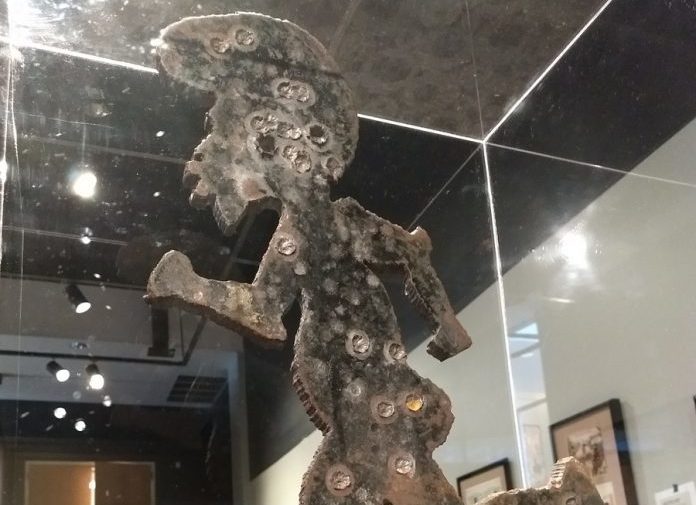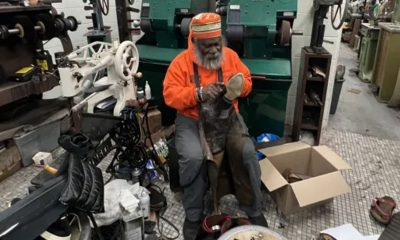Education
Memorabilia at Reginald F. Lewis Museum Seeks to Reclaim Racist Imagery
THE AFRO — Childish Gambino AKA Donald Glover’s “This is America” video debuted May 5. Since then, it has accumulated almost 380 million views on YouTube.

By J. K. Schmid, Special to the AFRO
Childish Gambino AKA Donald Glover’s “This is America” video debuted May 5. Since then, it has accumulated almost 380 million views on YouTube.
The video, opening with Glover’s strained unnatural pose reminiscent of the original caricature of Jim Crow, is planned to serve as a starting and end point of a new conversation about Black iconography at the Reginald F. Lewis Museum. “Hateful Things” and its companion exhibit “Reclaiming Racist Stereotypes” will display a history of consumer culture and present-day art, respectively.
The funhouse as something sinister is cliche, but the nausea and unease that comes from passing grinning grotesques of exaggerated Black faces one after another after another was palpable in the same way.
“Hateful Things” is a collection of consumer art spanning the better part of the two centuries since the fall of the antebellum South. The works are part of a travelling exhibit from The Jim Crow Museum of Racist Memorabilia at Ferris State University, Michigan. The relics tell a story of the evolution of a people held as property to a people held also as intellectual property.
Children’s storybooks, tobacco tins, calendars, otherwise mundane, everyday household items are emblazoned with every slur imagineable up through the 1950s.
“African-Americans, especially at the turn of the century, were used as a work force, and also as entertainment, and that has perpetuated, as entertainment,” Jackie Copeland, Director of Education and Visitor Services and curator of the two exhibitions, told the AFRO during a tour of the almost-finished exhibit.
There is a noticeable softening of the caricatures as the cruelest language falls out of favor. But the arrival of signature brands and faces like Aunt Jemima, Uncle Ben and Frank L. White (Cream of Wheat) in this larger context and often in their original portrayals reveals how recently the characters of Mammy, Sambo and Rastus began to fade from modern convention.
“You’re seeing that here, happy to cook, happy to serve,” Copeland said. “That is to perpetuate how African-Americans were to be perceived. If you look at what happened in the South, African-Americans, even though the Emancipation Proclamation was signed, many folks didn’t even know that they were freed. And the southerners would say ‘oh, you know, they like working on the plantation, they like living here, it’s fine.’”
Fade should be emphasized here. In an inspired use of the space, one of the earliest examples of mass-produced, mass-market hate, a Jim Crow makeup and wig kit is exhibited. At the end of the exhibition is a gruesome saggy do-ragged latex mask sold as “Plain Brown Rapper.” Overt to covert.
The political dynamic shaping this shifting consumer culture is also displayed. A 1926 Baltimore house title with restrictive covenant, barring its sale to Blacks sets this other scene alongside photographs of mock and real lynchings. A galling example of the impunity of White supremacy is a trophy case displaying a signature Lester Maddox (Jimmy Carter’s Lt. Governor) axe handle.
In stark contrast, “Reclaiming Racist Stereotypes” exhibits current art recontextualizing and repurposing the lurid into something alluring. The brilliant and controversial Kara Walker, a 1997 MacArthur Fellow perhaps most famous for her black cut-paper silhouettes and the colossal sugar sphinx “A Subtlety…,” will be featured with a pop-up book of some of her smaller silhouettes “Freedom, A Fable: A Curious Interpretation of the Wit of a Negress in Troubled Times.” Never constrained to one medium, Walker’s untitled set of six etched glass canisters similarly draw in the viewer to both beauty and horror.
Arvie Smith’s oils on canvas take back coarse Jim Crow images once owned by Whites, with their grim flat blacks, blood reds and bleached whites. Smith brings a resplendent spectrum of browns, oranges and gold, to a sordid and conflicted history. What once was threatening is now surreal. Still wrong, but not overpowering.
“Hateful Things” and “Reclaiming Racist Stereotypes” debuts to the public 6 p.m. August 30.
This article originally appeared in The Afro.













































